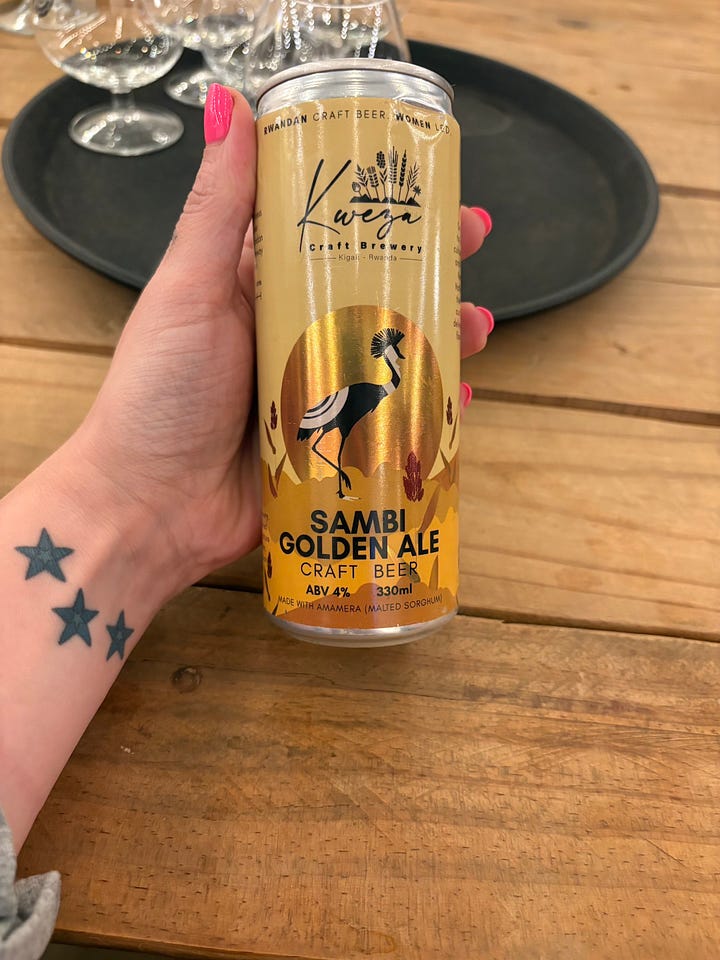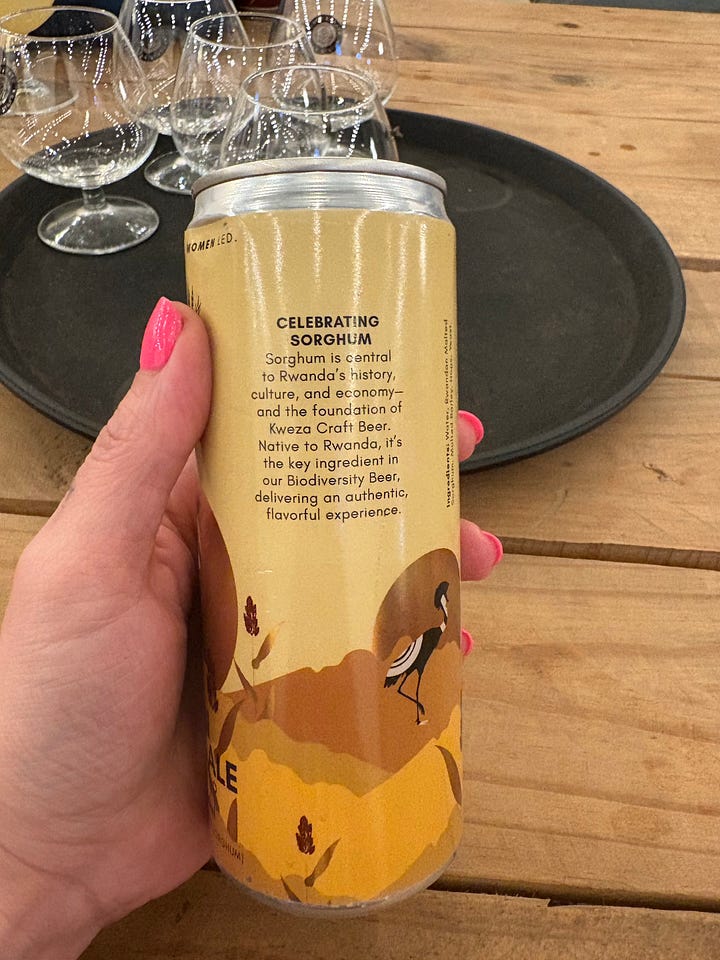Recently, I was having a conversation with a college student interested in working in the beer industry. Toward the end of our meeting, they asked me what advice I had for them. Among other things,1 I told them something that had been at the top of my mind for a few weeks:
Question everything.
There’s so much out there in the beer industry that just gets repeated over and over again, and no one seems to investigate where that information came from. No, caramel malts are not good for foam or head retention, even if a company calls them carafoam. No, American lagers don’t purposely have low levels of detectable acetaldehyde2 in them. No, cohumulone doesn’t have a “harsher” bitterness than humulone.
To paraphrase Richard Priess of Escarpment Labs (more on my love for Escarpment Labs below) - most of what we think we know about brewing science is based on an English translation of a German text3 and some guy’s Ph.D. thesis from the 70s.
Which leads me to why questioning everything has been on my mind lately. It will come as no surprise to anyone who has read this newsletter or been around me for more than five minutes, I’ve been specifically thinking about descriptive language and my blind spots in interrogating where we get our descriptive language. Nay, it’s more accurate to say that my thoughts about descriptive language have been challenged. The sensory nerd in me is thrilled.
First, I had done a presentation for the Beer Culture Summit entitled “So Fresh & So Clean: Examining Smell’s Role in Societal Hierarchy.” The presentation focused on how smell had been relegated to being animalistic and barbaric, not something that men, specifically white and/or moneyed men, should be concerned about. Reverse-engineered scientific theories explained that vision was the most important sense and that our olfactory bulbs were relatively smaller than the olfactory bulbs of other mammals because we had evolved free will.4
Then, I read this piece from Frauke Gaulia about how we describe scent from a visual standpoint because our language has been developed to talk about objects from a visual perspective.
This was one of those essays where reading it exploded my brain a little bit. The concept that we describe smell from a visual perspective, and that one of the reasons we have a hard time describing smells is because we can’t see them, had never occurred to me. It was so obvious when I read it, though. I even felt a little sheepish. Here I am championing our sense of smell while explaining how it has been relegated to a lesser sense, all while not thinking about where our descriptive language comes from, sense-wise.
Dang.
Then, I traveled to South Africa to judge in the African Beer Cup. While there, I was finally able to meet an online friend in person - Jessi Flynn of Kweza Craft Brewery, located in Kigali, Rwanda.
During a presentation on alternative5 grains for brewing, Jessi told the audience that she was excited to have a group of beer judges taste their sorghum beers and discuss descriptors specific to sorghum. Not, she emphasized, how sorghum tasted different from barley and other brewing grains, or trying to shoehorn sorghum flavors into the existing flavors for barley.
Sorghum is its own grain, commonly used in African and Asian brewing as well as gluten-free brewing. She advocated for the development of better flavor descriptor criteria for African grains, which also included millet and fonio. A new grain standard, rather than relying solely on the barley standards.


Up until that point, I think the only time I had tasted a 100% sorghum beer was when I tried Redbridge a few years ago. That’s kind of the equivalent of only tasting macro light lager and then trying a Pilsner made by a craft brewery. The flavors were indeed different from the flavors imparted by more Eurocolonial malted grains, which made it challenging to think of descriptors.
This is not insurmountable, though. I vividly recall learning about an ingredient called hops in beer and how they make beer bitter. I remember asking someone, “So when I taste bitterness in beer, that’s from hops?”
And look at me now.
Beer in Eurocolonial societies remains monocultural. “New” beer styles are still largely homogenous within established beer styles. IPAs can be anything now! But they’re still IPAs. The industry is still extremely hierarchical, and the Sainted Men of Brewing are still trotted out as the pinnacle of skill, even if the expertise they developed 20+ years ago may sometimes be a little tarnished, a little out of style, and maybe even a little embarrassing, like when one of your Boomer family members posts a declaration on Facebook that Meta does NOT have their permission to use their photos.
There is relatively little patience given to alternative perspectives or practices. The very small space that is sometimes begrudgingly ceded to new voices and practices becomes infested with armchair brewers who are more dedicated to denouncing and presenting strawman arguments than to understanding.
Which leads me back to the title of this month’s newsletter and my “question everything” advice. Taking a more multicultural approach to descriptive language is a big lift, but not an impossible one. On an institutional level, it requires fighting the idea that building a lexicon necessarily requires the solicitation of experts in that particular field. On an individual level, it requires us to identify our own blind spots and biases and work towards broadening our understanding of different cultures.
As I noted a couple of years ago, I frequently brought this up while completing the UC-Davis Applied Sensory and Consumer Science program. How would sensory science look different if it were more inclusive? The pushback I received was that outcomes were largely the same when “more diverse” sample populations were used. Sure they were - I look forward to seeing this finding written up in Convenient Theories for You magazine, along with “Did You Ever Think That Maybe Women and Black People Don’t Apply Because They Don’t Want to Work in Beer?” and “Actually, One of Our Female Employees Came Up With The Name So It’s Not Sexist.”
I continue to mull this topic over in my head, thinking about how much opportunity there is to expand our descriptive language and wondering what descriptive language I’ve accepted as doctrine without examining where that language arose. Or that I’ve accepted because it’s based on what we can see versus more ephemeral bases like emotions.
I challenge you to do the same, particularly when you find yourself trying to fit the round peg of global flavors into the square hole of Eurocolonial flavors. And let me know what you find!
How do you eat an elephant? One bite at a time.
And finally…
Before we leave each other, here are a few more things I am up to these days:
Leaving social media. It’s such a millennial thing to make a grand announcement about leaving social media. It also seems like white women’s essays about their changing relationship with the internet and social media are the grown-up version of the college application essay. The Lunchables to charcuterie board pipeline. I know I get at least two newsletters weekly about the subject. However, this one really broke me, and I’ve revisited it almost every day since I read it:
all my friends and i talk about is getting rid of our phones
Listening to The Escarpment Labs Podcast by Escarpment Labs. I am a HUGE fan of the education that Escarpment Labs puts out. Having spent a not insignificant amount of the last ten or so years studying beer, it’s not often anymore that I hear new-to-me knowledge, and their first episodes on pressure fermentation and pitch rate have so much great information explained in an approachable way. Yeast is the ultimate NIMBY? GTFOutta here with that amazing metaphorical example.
Preparing to undergo a hysterectomy. This may seem a little TMI for a newsletter, and I vacillated on whether it’s appropriate to include it here. However, I live in a state that kept a dead woman “alive” as an incubator against her family’s wishes to extract a baby from her corpse, and also prefers to let pregnant people bleed out in hospital parking lots rather than giving them lifesaving medical care. In my waning fertile years, I chose to make certain there is no way I can get pregnant. If you’re the kind of person who views these stories as somehow not real life or thinks that it doesn’t affect you, now you know someone who has chosen to get organs removed from her body because she knows her life is worth less than a clump of cells in the state where she resides. Abortion is healthcare.
You will encounter sexism and otherwise inequitable treatment of yourself and others. Don’t internalize it and think you’re alone or you did something wrong. Don’t suffer in silence - confide in trusted people and speak up for yourself when you feel safe to do so. Speaking up for yourself and others gets easier the more you do it.
I will WeLL AKshuAlLy myself here and say that acetaldehyde is present in all finished beers at levels typically well below our detection thresholds.
This is an example of a misinterpretation of someone else’s work. Paul Broca was working on an explanation of why humans have free will, while other animals do not seem to. He pointed to the relative size of our olfactory bulbs compared to other animals. As noted in the footnote below, our olfactory bulb size is independent of the size of our other brain regions. Broca decided that the sense of smell drives irrational behavior in animals, but humans can choose how to respond to smells. Almost immediately after making this bold declaration, Broca died. Shortly thereafter, an English anatomist mistranslated Broca’s conclusion. Rather than being a statement about humanity’s free will, he decided Broca was instead saying that humans are bad smellers and dogs are good smellers. Hence, the myth that humans are bad at smelling was born.
All scientific theories are just that - theories. Even germ theory and the theory of gravity. We take the information we have available at the time and try to make sense of the world around us. Many theories, however, were developed as a way to justify othering people based on class, gender, and later ethnicity and race. Intuitively, the explanation that humans are bad at smelling makes sense to me. As in, I can understand how that theory made sense given the information available at the time. Across mammals, the size of any given brain region is proportional to the overall size of the brain. The human olfactory bulb is the exception to this rule in that our olfactory bulb size is independent of the size of other brain regions.
More Eurocolonial language - alternative for who? Grains like sorghum and millet have been used in brewing for a very long time, particularly in Asia and Africa, which make up about 60% and 18% of the world’s population, respectively. Europe and North America make up about 18% of the world’s population combined. So……..alternative for who?




Always sooooo good to get notifications about a new piece of writing from you! And yes, here's to the fine humans of Escarpment Labs! Some of Canadaland's finest.
Today’s Substack is why I adore you. We absolutely need question everything and rethink about beer flavors. Damn, now you make me want to write a thesis on flavors and smells in beer.
PS. Best wishes on your surgery! I hope it goes smoothly and there are no complications. I have been giving it some thought as well.